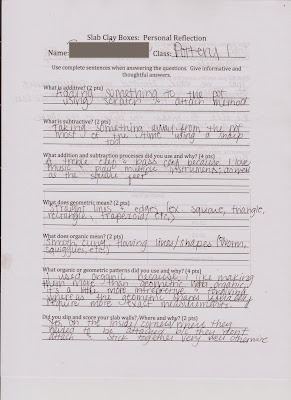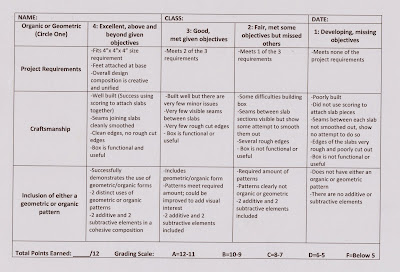Today my partner and I went to Bloomer High School for our
last practicum observance, and while it was a great relief to have our
observance hours completed, it was also bittersweet. For our Pottery I/II class, we had students
fill out a reflection worksheet, which asked them what they have learned as
well as asking them personal feelings towards the assignment. Here is one example of a student’s reaction
to the assignment:
While my partner and I might have chosen a lesson that was a bit ambitious to tackle in three days, the end results were successful. Over 90 percent of the class followed the objectives given to them and were beautifully executed! Here are some examples of the students' work:
I cannot even begin to describe how much of a learning experience I received going through practicum. Perhaps the best piece of information I learned from this experience was how to work with high school students. High school can be a challenge for both students and for teachers to teach, especially at the high school level, where in most school districts, art is no longer required for students to take after eighth grade. Many students at this age level approach art with an impassive attitude and feel that it will be an "Easy A" class. Throughout my observation, I could see that many of the students enrolled in in the art classes had this attitude and it showed in their work. One student in the Pottery I/II class openly admitted to me that she thought that this was going to be an easy class, and it was a lot more difficult than she thought it would be. One thing I wish I could go back and change was how quickly I learned about the students. As an introverted person, I tend to take a while getting to know others, and I wish I went in head first right away getting to know them. By the time I got to know the students, our practicum experience was almost over with. I can only take this experience and improve on it by being more willing to ask my students about them in order to both create a rapport with them and to create a curriculum that openly engages my students. Another thing I learned from this experience that I will carry on throughout my teaching career is that it is okay to make mistakes and it is okay to not have a successful lesson. In this case, one can only take the information from this experience and make adjustments and improvements to make the lesson successful and a positive experience for both the teacher and the students.








